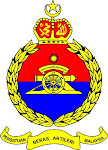Observer Party training in the good old days were confined to the creative "Puff" range.All regiments had a small space, usually a classroom size building, tucked away to build one. The idea was simple, based on a selected map area. The rest was good carpentry, innovative landscaping with Hessian and other self help materials. Commanding Officers were insistent on the existence of puff range in units, and many of us can recall, I am sure, the torturous hours for OpO, OP act and Signaller. If you were the unit IG or AIG, invariably, you get the responsibility for the upkeep of this wonderful facility. It was a superb, cheap and cheery, tool to run through complete fire orders,basic OP drills and of course the voice procedure in signals communication.
Initially, it was designed with chemical mixtures to simulate the "smoke" effect for fall of shot, but when the supply ran out, cigarettes became the alternative. I must say that there was no short supply of this stuff, as the regiments were littered with smokers, and what was a few sticks sacrifice for regimental training? No problemo!
We took a quantum leap in the late 70's to acquire our first simulator- The INVERTRON. I was exposed to the SAAB simulator in Larkhill, just as all our IGs and AIGs trained in the UK then. Invertron had a few better features compared to the SAAB. These systems were the forefathers of electronic simulation training for Artillery Observers. Yes, they were expensive ,obviously compared to the puff range, but the training value was immense, not to mention cost effective. Today, we look back at these systems as "dinosaurs", with huge space requirements for basic computers and large floppy discs. The scene displays were few and very simple. Simple targets could be simulated and most missions could be exercised.
Today, the evolution has reached 3D displays, digital terrain maps, extensive CGI effects and very realistic sound effects too. So, many players too have come into the game given that many nations decided too build their own systems to meet their individual needs. We too have the potential to develop our own with technology transfer and off the shelf components.
Whatever the system the training needs remain the same, and it is vital to maintain battle efficiency of our observer teams with cost effective simulation. A well structured exercise developed to meet the ascending needs of the trainees is the key to achieve success in training. It is pointless to have a high end simulation system without creative exercise planning and incremental learning. The Artillery School is pivotal to develop such skills among its IGs, TIGs and AIGs. In essence, the equipment suppliers must be capable to develop the means to allow the users to "grow". It is this main factor that shall keep the Artillery in the forefront of simulation training.
Good Luck Gunners!









